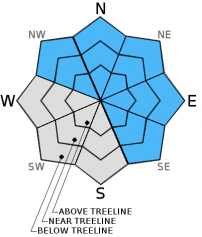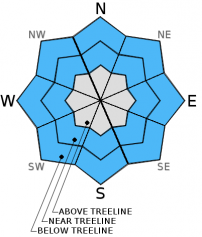| Sunday | Sunday Night | Monday | |
|---|---|---|---|
| Weather: | Mostly cloudy to cloudy with a chance of rain. | Cloudy with snow and rain | Mostly cloudy with snow showers likely |
| Temperatures: | 39 to 46 deg. F. | 26 to 33 deg. F. | 31 to 38 deg. F. |
| Mid Slope Winds: | South | Southwest | Southwest |
| Wind Speed: | 25 to 30 mph with gusts to 45 mph increasing to 35 to 40 mph with gusts to 65 mph in the afternoon | 30 to 40 mph with gusts to 60 mph | 20 to 30 mph with gusts to 55 mph decreasing to gusts to 40 mph in the afternoon |
| Expected snowfall: | 0 | 4 to 8 | 3 to 5 |
| Sunday | Sunday Night | Monday | |
|---|---|---|---|
| Weather: | Mostly cloudy to cloudy with a chance of rain and snow. | Snow | Mostly cloudy with snow showers likely |
| Temperatures: | 35 to 42 deg. F. | 24 to 31 deg. F. | 27 to 34 deg. F. |
| Ridge Top Winds: | Southwest shifting to the south in the afternoon | Southwest | Southwest |
| Wind Speed: | 40 to 45 mph with gusts to 65 mph increasing to 50 to 55 mph with gusts to 85 mph in the afternoon | 40 to 50 mph with gusts to 75 mph | 40 to 45 mph with gusts to 70 mph decreasing to 30 to 35 mph with gusts to 55 mph in the afternoon |
| Expected snowfall: | up to 2 | 5 to 10 | 3 to 5 |

























